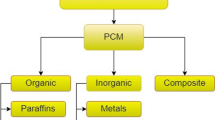Abstract
The use of MgO and TiO2 nanofluids at different concentrations was investigated annually to evaluate the distillate output of stepped solar stills. Nanofluids concentrations ranged from 0.1 to 0.2% in the present research work. Results confirm that the stepped solar still distillate output is increased by 45.8%, 33.33%, 20.4% and 4.1% with use of MgO nanofluids (0.2% and 0.1% concentrations) and TiO2 nanofluids (0.2% and 0.1% concentrations). The reason for higher distillate output of MgO nanofluid over TiO2 in stepped solar still is lower specific heat capacity and higher thermal conductivity. Finally, the energy payback time was also calculated, and it was still only 3 months for stepped solar stills with the use of 0.2% nanofluid concentration.








Similar content being viewed by others
References
Kabeel AE, Sathyamurthy R, Sharshir SW, Muthumanokar A, Panchal H, Prakash N, Prasad C, Nandakumar S, El Kady MS. Effect of water depth on a novel absorber plate of pyramid solar still coated with TiO2 nano black paint. J Clean Prod. 2019;213:185–91.
Awasthi A, Kumari K, Panchal H, Sathyamurthy R. Passive solar still: recent advancements in design and related performance. Environ Technol Rev. 2018;7(1):235–61.
Panchal H. Experimental investigation of varying parameters affecting on double slope single basin solar still. Int J Adv Eng Sci. 2011;2(1):17–21.
Panchal H. Life cycle cost analysis of a double-effect solar still. Int J Ambient Energy. 2016;61:86–96.
Panchal H. Performance investigation on variations of glass cover thickness on solar still: experimental and theoretical analysis. Technol Econ Smart Grids Sustain Energy. 2016;1(4):1–7.
Panchal H. Experimental analysis of diesel engine exhaust gas coupled with water desalination for improved potable water production. Int J Ambient Energy. 2018;38(6):567–70.
Panchal H, Mevada D, Sathyamurthy R. The requirement of various methods to improve distillate output of solar still: a review. Int J Ambient Energy. 2018. https://doi.org/10.1080/01430750.2018.1542630.
Panchal H, Awasthi A. Theoretical modeling and experimental analysis of solar still integrated with evacuated tubes. Heat Mass Transf. 2017;53(6):1943–55.
Malik M, Tiwari G, Sodha M, Kumar A. Solar energy conversion and photo energy systems. Sol Distill. 1982;2:1–10.
Panchal H, Shah PK. Effect of varying glass cover thickness on performance of solar still in winter climatic conditions. Int J Renew Energy Res. 2011;1:212–23.
Panchal H, Sanjay P. An extensive review on different design and climatic parameters to increase distillate output of solar still. Renew Sustain Energy Rev. 2017;69:750–8.
Panchal H, Shah PK. Investigation on solar stills having floating plates. Int J Energy Environ Eng. 2012;3(1):1–5.
Panchal H. Experimental analysis of diesel engine exhaust gas coupled with water desalination for improved potable water production. Int J Ambient Energy. 2018;38(6):567–70.
Shukla A, Kant K, Sharma A. Solar still with latent heat energystorage: a review. Innov Food Sci Emerg Technol. 2017;41:34–46.
Omara ZM, Kabeel AE, Abdullah AS. A review of solar still performance with reflectors. Renew Sustain Energy Rev. 2017;68:638–49.
Celata GP, Annibale FD, Mariani A. Nanofluid flow effects on metal surfaces. Energia Ambiente e Innovazione. 2011;4–5:94–8.
Hirt CW, Nichols BD. Volume of fluid (VOF) method for the dynamics of free boundaries. J Comput Phys. 1981;39:201–25.
Yang Y, Zhang ZG, Grulke EA, Anderson WB, Wu G. Heat transfer properties of nanoparticle-in-fluid dispersions (nanofluids) in laminar flow. Int J Heat Mass Transf. 2005;48:1107–16.
Elango T, Kannan A, Murugavel KK. Performance study on single basin single slope solar still with different water nanofluids. Desalination. 2015;360:45–51.
Sahota L, Tiwari GN. Effect of Al2O3 nanoparticles on the performance of passive double slope solar still. Sol Energy. 2016;130:260–72.
Sahota L, Tiwari GN. Effect of nanofluids on the performance of passive double slope solar still: a comparative study using characteristic curve. Desalination. 2016;388:9–21.
Sahota L, Tiwari GN. Effect of Al2O3 and TiO2-water based nanofluids on heat transfer coefficients of passive double slope solar still. Int J Energy Environ Econ. 2016;24:1–18.
Sahota L, Tiwari GN. Exergoeconomic and enviroeconomic analyses of hybrid double slope solar still loaded with nanofluids. Energy Convers Manag. 2017;148:413–30.
Chen W, Zou C, Li X, Li L. Experimental investigation of SiC nanofluids for solar distillation system: stability, optical properties and thermal conductivity with saline water-based fluid. Int J Heat Mass Transf. 2017;107:264–70.
Mahian O, Kianifar A, Kalogirou SA, Pop I, Wongwises S. A review of the applications of nanofluids in solar energy. Int J Heat Mass Transf. 2013;57:582–94.
Kabeel AE, Omara ZM, Essa FA. Improving the performance of solar still by using nanofluids and providing vacuum. Energy Convers Manag. 2014;86:268–74.
Sharshir SW, Peng G, Wu L, Yang N, Essa FA, Mohamed SIT, Kabeel AE, Elsheikh AH. Enhancing the solar still performance using nanofluids and glass cover cooling: experimental study. Appl Therm Eng. 2017;113:684–93.
Sahota L, Shyam, Tiwari GN. Energy matrices, enviroeconomic and exergoeconomic analysis of passive double slope solar still with water based nanofluids. Desalination. 2017;409:66–79.
Rashidi S, Bovand M, Rahbar N, Esfahani JA. Steps optimization and productivity enhancement in a nanofluid cascade solar still. Renew Energy. 2018;118:536–45.
Gupta B, Kumar A, Baredar P. Experimental investigation on modified solar still using nanoparticles and water sprinkler attachment. Front Mater. 2017. https://doi.org/10.3389/fmats.2017.00023.
Panchal H, Shah P. Performance analysis of solar still having different plates. Int J Energy Sci. 2016;2(1):1–6.
Author information
Authors and Affiliations
Corresponding authors
Additional information
Publisher's Note
Springer Nature remains neutral with regard to jurisdictional claims in published maps and institutional affiliations.
Rights and permissions
About this article
Cite this article
Panchal, H., Sathyamurthy, R., Kabeel, A.E. et al. Annual performance analysis of adding different nanofluids in stepped solar still. J Therm Anal Calorim 138, 3175–3182 (2019). https://doi.org/10.1007/s10973-019-08346-x
Received:
Accepted:
Published:
Issue Date:
DOI: https://doi.org/10.1007/s10973-019-08346-x




